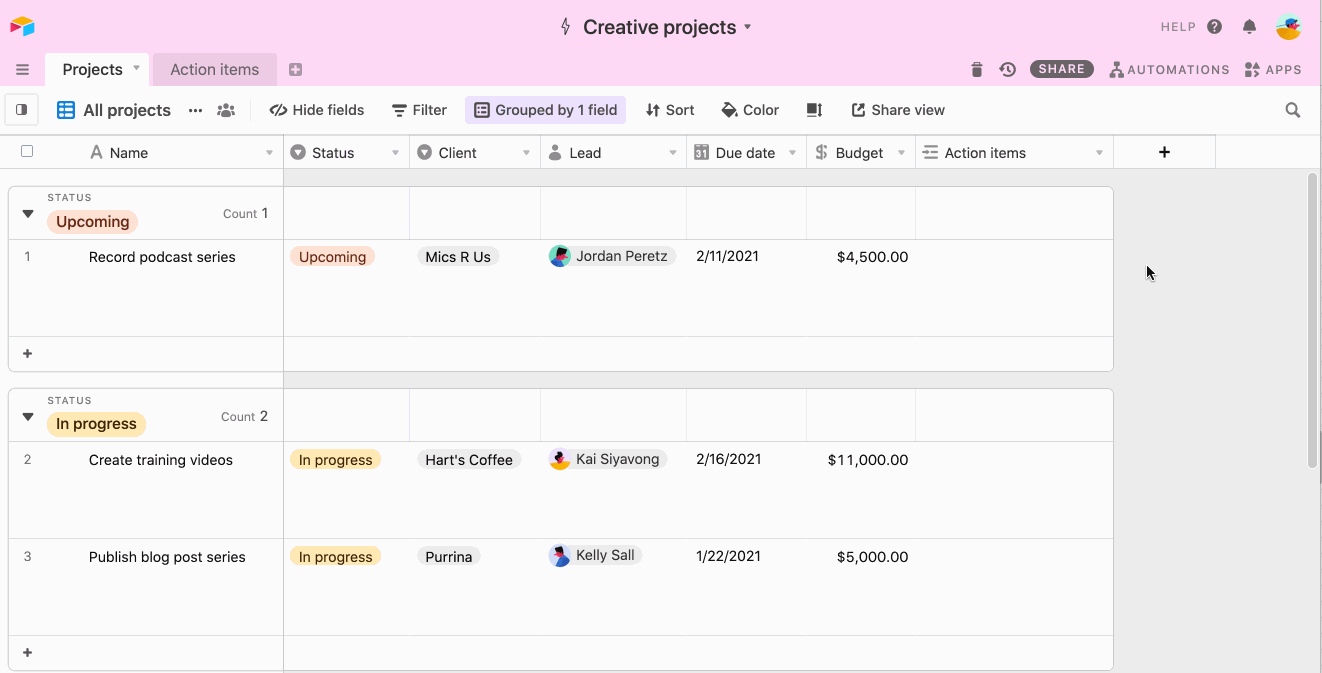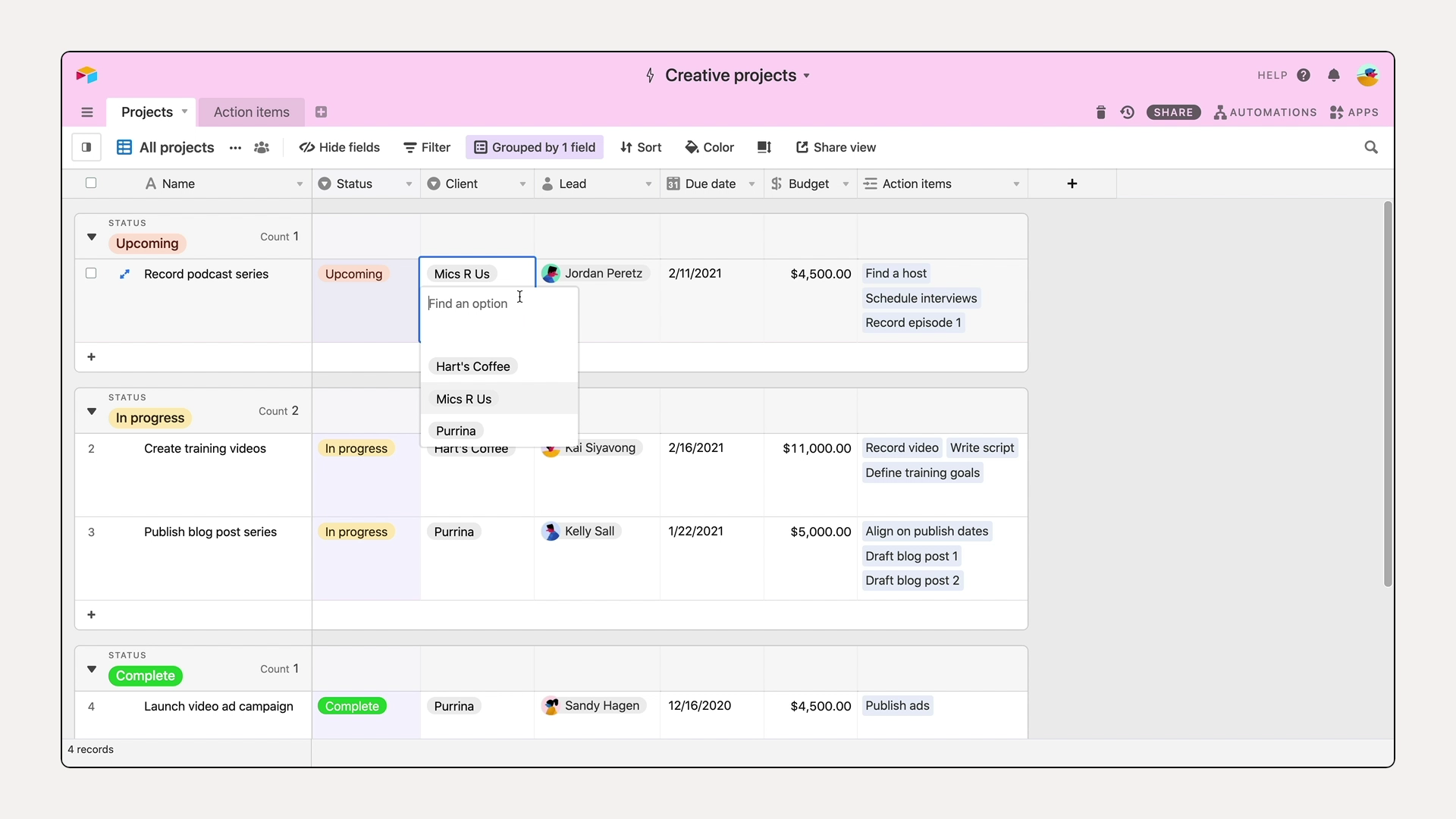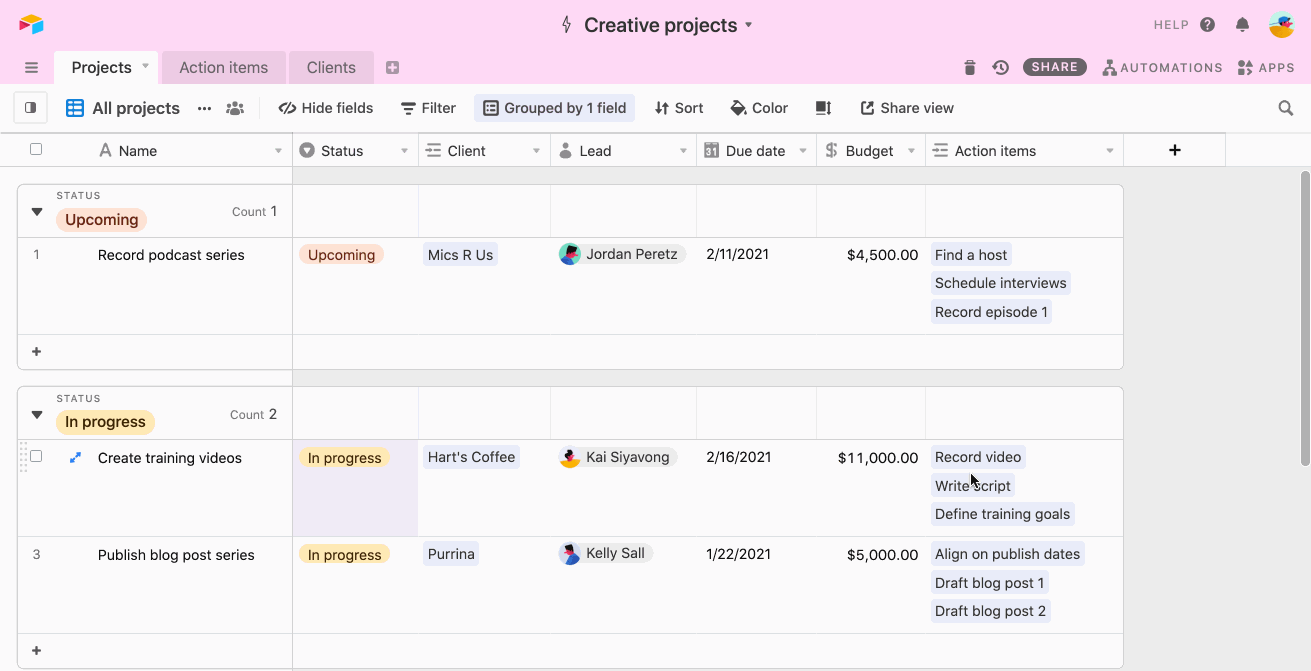All plan types | |
Platform(s) | Web/Browser, Mac app, and Windows app |
Try it in Airtable |
Linking records in Airtable
Step 1: Define your relationships
Before you start building relationships between your records, you’ll want to make sure you know what those relationships should look like.
What information you’re tracking, and how it connects together, is completely dependent on your workflow. You might have a list of projects, a list of action items, and a list of clients. Or maybe you have a list of events, a list of attendees, and a list of venues.
In Airtable, it’s a best practice to capture each of these lists in a separate table, where you can store each item and all of its details. But keeping your lists in separate tables doesn’t mean they have to live in isolation—and they shouldn’t! Our projects have related action items, events have attendees, and so on. In the next step, we’ll talk about how to create these connections in your Airtable base.
For now, think about your workflow and map out which information you want to connect together. Make sure you have each piece of information stored in the right table before you move on (if you want more help thinking through the right table setup, check out this guide to structuring your base effectively).
Step 2: Create your relationships
Option 1: Create a link between two existing tables
The first step in creating those valuable relationships in your workflow—projects to action items or attendees to events—is to create a linked record field. Since you’re creating a link between both tables you can create this field in either related table.
Once you have your linked record field created, clicking the + icon will bring up the records of the linked table to select from. You can now link individual records together, relating this project to these action items, for example. This will create the relationship between those two specific records.

Anytime you link two records together, you’ll notice that the association is mirrored in the other table. These reciprocal links allow you to see related information in each table so you know which action items are related to which project and which projects are associated with which action items.
Go ahead and create your linked records. First, create the linked record field to capture the relationships you had mapped out in the previous step between two related tables. Once you have the linked record field added, link relevant records together from either table.
Option 2: Convert an existing field into a new linked table
It’s normal that as your workflow grows in complexity, you will need to manage additional information. Using linked records, it’s simple to expand any dimension of your table into a separate, linked table so you can add more context.
For example, with only a few clients, it’s easy to keep on top of client–project relationships with a single select or single-line text field. In doing so, you limit client information to their name which is the option captured in the single select.

As your client list grows, you may want to track additional information for each client: their address, logo, preferred payment method, or point of contact.
To expand any dimension of your workflow, you can create a linked record from an existing field. This will create a new table from the values in your existing field, creating one record for each value. The new table will have linked records to the original table maintaining the existing relationship.
Now that the clients are tracked in a separate table, you can add additional information that’s important to the new dimension of your workflow without losing the connection to your projects.
Consider which elements of your workflow (venues, clients, products, or anything else!) you would like to expand the information tracked beyond a single field. For any element identified, turn that field into a linked record, and add additional details to the new linked table.
Step 3: Leverage your relationships
Workflows are always evolving and so is the information they contain. With relationships established between your different tables, you can use your linked record fields to see relevant information at a glance and create a single source of truth.
Want to see the status of action items related to a project without leaving your table? Enlarge the linked record field to see additional fields for each linked record. Want to further hone in on a specific action item? Expand any linked record to see all of its details and fields.

With your linked record fields, you can also keep consistent information across your workflow. Using a lookup field, you can dynamically display information stored in linked records. Any updates to the original field will persist in the lookup.
Say you want to keep an eye on the project due date for your action items. To do so, you can create a lookup field in your action items table that will pull in each linked project’s due date. Any changes to the project due date will be automatically reflected across all action items tied to that project. Now you have a single place to update your information which gets rippled across your workflow keeping your information consistent and eliminating any duplicative data entry.
Try accessing your connected information across tables by expanding a linked record to view all of its details. Next, create lookup fields so you can see the information where you need it for any fields that could be relevant across linked tables.
Using AI in linked records
Understanding Airtable AI in linked records
Linked record fields include the option to use AI to suggest linked record matches. If a creator sets this option, they can configure which fields on the origin table and linked record table are relevant for the matching. Users viewing the linked record picker will then see AI-powered “Top matches” in addition to being able to choose from any of the linked records. This helps users to quickly find the closest matching linked record in order to send a record to the right person, team, or view/interface for review, approval, or to inform decision-making.
Ultimately, this feature will have AI suggest relevant records that match the values in similar records. This means that results can get better over time as you continue to build linked record relationships across your tables.
Turning on AI powered linked record matching
Users who are creating linked record fields in a workspace where AI has been enabled can have AI help to generate top matches.
Visit your Airtable homepage.
Create or open your preferred base.
Add or edit a field.
Search for and select Link to another record.
Toggle on the “Use AI to show top matches when selecting a record” option.
You’ll then need to select one or more fields in each table for the AI to understand the context of the record that you are working in. This also can help the AI to ignore certain fields that may not contain information that will be relevant to the linked record field. More in the best practices section below.
Once you have finished configuring the fields click Create field if this is a new formula field or click Save if this is an existing formula field that you modified.
Best practice tips for using AI to generate top matches
When choosing the fields to help the AI narrow it’s results:
The more links you make, the better the AI will be at matching.
AI will make suggestions based on previous selections made for similar records.
It’s best to use fields with text-based outputs, especially the one or ones that provide the most descriptive context about the record such as a category from a single or multiple select field, or text fields containing names and descriptions.
For example, if you want to have the AI suggest linked records that reveal a relationship between certain projects and tasks, then you would select “Project name” and “Project type” fields in the project table and “Task name” and “Descriptions” in the other.
It’s also best to use fields that offer as concise of information as possible.
For example, a long text field with a lot of information may not utilize all of text in the cell as the AI would ignore any content over a couple hundred words for the purposes of matching.
We don’t recommend using number-based or date/time-based fields, because the AI is not calibrated to detect these types of relationships.
Linking records within the same table
What are self-linked records?
Self-linked records are linked record fields that connect records within the same table, which can be used to show relationships like:
Team members and their managers
Tasks and their subtasks
Projects and their subprojects
Related items that reference each other
How do self-linked records work?
When creating a linked record field that references your current table, Airtable automatically creates a corresponding reciprocal linked record field.
This reciprocal field will be named "From field: [Your Field Name]" and shows the inverse relationship.
Self-linked records examples:
When creating a "Manager" field, Airtable automatically creates a "From field: Manager" field that can be renamed "Direct Reports."
When creating a "Parent Task" field, Airtable automatically creates a "From field: Parent Task" field that can be renamed "Subtasks."
Creating self-linked record fields
Note
Adding or changing links in either field automatically updates the corresponding records.
Links can be added or removed in both directions.
To create self-linked record fields:
Open your Airtable homepage.
Open the base where you want to crate a self-linked field.
Click the + icon the right of the your base’s last field.
Search for and select Link to another record.
When prompted to select a table to link to, choose your current table
Airtable will automatically create the reciprocal field named "From field: [Your Field Name]."
You can then rename reciprocal field.